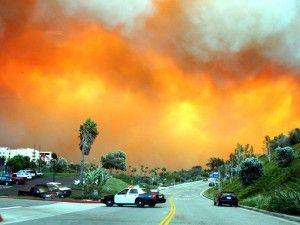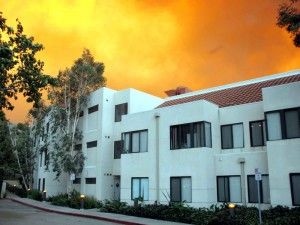
The threat of brush fires is an ever-present danger in Malibu and at Pepperdine. Even in seemingly harmless conditions, it’s always important to be prepared and remain alert.
Typically, fire season in Los Angeles County runs from September to November.
“October is generally one of our busier months for brush fires,” said Matt Levesque of the LA County Fire Department. This has much to do with the local environment.
The Malibu ecosystem is home to highly flammable brush called chaparral, which consists of small plants that are not only drought-resistant, but some of the most flammable in the world. The already dry conditions become serious fire hazards, when the Santa Ana winds blow through Southern California in early fall.
“The season depends on precipitation in the winter months,” Levesque explained. “This affects how tall the grass and the brush get in certain areas.”
In coastal areas, such as Malibu, the heavier brush starts to burn in October.
“The real threat is from the Santa Ana winds. These are offshore winds with no dampness and no humidity,” he said.
LA County has annual brush clearance requirements, and building codes require the use of fire-resistant materials.
“We just wrapped up our annual brush clearance,” said Rob McKelvy, deputy director of Emergency Services at Pepperdine. The department always ensures that it’s following the requirements the Fire Department has for the university.
In this climate, the most effective form of preparation is prevention.
“You can have 100 extra engines sitting, waiting for a brush fire, but if the conditions are ripe, the winds are strong, and the fire’s severe, the first line of defense will be if the homeowners have proper brush clearance and have built their homes to the proper fire codes,” McKelvy said.

The Lost Hills Sheriff’s Department is also taking certain precautions.
“The most important thing is to educate the community,” said Sgt. Arnold of the LA County Sheriff’s Department. “We remain vigilant, and send out Fire Watch patrol teams whenever certain humidity and temperature levels are reached.” These teams are made up of department deputies and local volunteers.
This fall, the threat of wildfires is still a concern, but an average season is expected.
“There is still a lot of fuel that hasn’t burned since 2006,” McKelvy said, in reference to the brush conditions on campus. “In a decade, this is the first year we haven’t had a drought, but that doesn’t mean the threat is gone.”
Levesque advises to have a plan in case of an evacuation. “People should be prepared by having important documents and paperwork in one area.” It is also important to have a few escape routes in mind.
The last major wildfires that occurred in Malibu were in 2007. During the first fire, the flames reached all the way to campus, burning Malibu Presbyterian to the ground and surrounding the Phillip’s Theme Tower.
The scope of the second fire was so extensive that 2,400 people in Malibu, including Pepperdine students, had to be evacuated.
The University’s Department of Emergency Services is continuously putting information online regarding preparing for natural disasters such as wildfires, and has conducted RA and SLA training on fire preparedness.
Even with the most thorough preventative measures, fires cannot always be avoided, however, if safety regulations are followed, the response should be effective enough to contain them.


